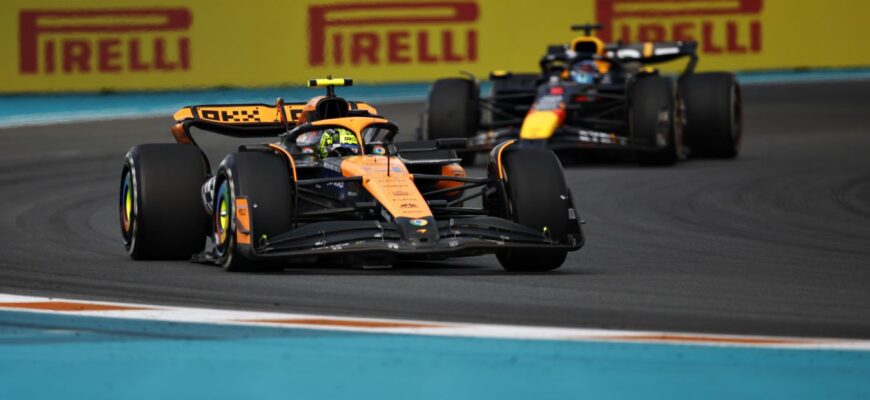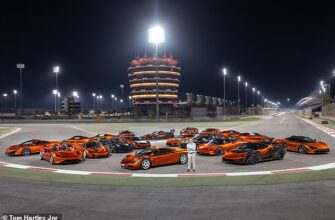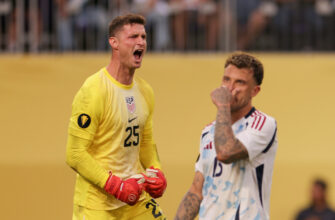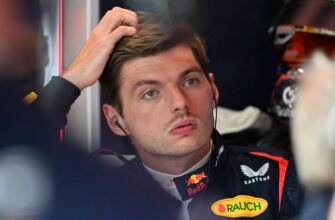MELBOURNE, Australia — Lando Norris’s mere 0.8-second victory over Max Verstappen at Sunday’s Australian Grand Prix doesn’t accurately reflect the superior performance of his McLaren MCL39 around Melbourne’s Albert Park circuit.
Amidst the excitement and incidents of Formula 1’s chaotic season opener, McLaren demonstrated periods of genuine dominance. However, as the checkered flag waved, Verstappen, Norris’s long-standing rival, remained closely behind, applying pressure until the very last corner.
It’s not to suggest Norris should have won by a larger gap, but if the race hadn’t been interrupted by frequent chaotic moments, his lead would almost certainly have been more substantial. Norris effectively managed challenging weather conditions on Sunday, as multiple waves of heavy rain swept across the track, delivering one of his most compelling performances to date.
Gone was any hint of the hesitation that might have cost him pole position on the first lap, or any sign of faltering under Verstappen’s pressure as seen 12 months prior. Instead, Norris maintained a relentless focus on victory from the outset, proving both his and McLaren’s significant progress over the winter in their pursuit of the 2025 drivers’ championship.
- Good for TV
- Editor’s Picks
- 75 years of innovation: How F1 has evolved since 1950 and where it’s headed 8d
- If Hamilton is in F1 title fight, Leclerc expects to be, too 7d Laurence Edmondson
- F1 2025: A reason to root for each driver, a question facing every team 14d Laurence Edmondson and Nate Saunders
- LISTEN TO ‘UNLAPPED’
Good for TV
Still in his champagne-soaked racing suit, with adrenaline still coursing through him, Norris spoke to the media on Sunday evening, reflecting on an eventful afternoon.
‘Starting the season with a victory is satisfying, but achieving it in such a demanding race, where mistakes are easily made and everything can be ruined, makes it even more rewarding,’ he stated. ‘Things can go wrong so quickly in any moment of the race — a lock-up, a slight error on the white line, a sudden slide… it was often challenging to avoid ending up in a wall or tire barrier.’
Following his own eventful race, Verstappen saved his best performance for the final stages, closing the gap to Norris in the last laps. It was later revealed that Norris’s car had sustained floor damage, impacting its performance in the final stint. However, highlighting Norris’s exceptional driving, Verstappen never truly believed he could successfully overtake.
‘I just pushed to close in, tried to apply some pressure, but overtaking is incredibly difficult here,’ Verstappen commented post-race. ‘There was only one dry line; even if I got close approaching Turn 9, I’d have to drive on the wet surface, limiting overtaking opportunities. But at least it was close, making it exciting for TV.’
About 30 laps prior, the television spectacle wasn’t as captivating. Despite Verstappen’s initial efforts to challenge the McLarens at the start, he ran wide at Turn 11 on lap 17, losing second place to Oscar Piastri.
With a dry line gradually forming but conditions still too damp for slick tires, the McLaren’s true capabilities emerged on their aging intermediate tires. Running first and second, Norris and Piastri extended their lead over Verstappen by a significant 16 seconds in the following 13 laps.
The tendency of Pirelli’s intermediate tires to overheat on drying asphalt amplified a built-in advantage of the new McLaren over its competitors. This characteristic was initially observed in Norris’s impressive long-run data during preseason testing in Bahrain and also played a role in the qualifying performances of both McLaren drivers in Australia.
Verstappen noted that McLaren’s tire management was a decisive factor in Sunday’s race and a key area where the reigning constructors’ champions are currently ahead.
‘I could see McLaren’s advantage coming,’ Verstappen said, referring to the first stint. ‘I struggled with tire degradation, similar to yesterday’s qualifying.’
‘Intermediates are an even softer compound, making them more susceptible to overheating. This is where we – and many teams – are behind McLaren. They are simply performing better in this aspect, which is something we need to improve.’
McLaren team principal Andrea Stella admitted surprise at his team’s significant advantage over rivals so early in the season.
‘Today, we again witnessed the car’s excellent interaction with the tires. In the first stint, we managed to create a gap to other cars, which isn’t solely due to the car itself, but also its gentle handling of the tires,’ he explained. ‘So, in some ways, the extent of our competitiveness is a bit surprising, but the objective itself is not unexpected.’
Oscar Piastri discusses his ‘mistake’ at the Australian Grand Prix, which resulted in him sliding onto the grass in front of his home crowd.
‘The car seems to have met some of our targets. The full extent will become clearer in the upcoming races, giving us a better understanding of the competitive order. Also, we haven’t really seen Ferrari’s true pace this weekend. I suspect they are quite close to us, so we’ll learn more.’
Norris echoed this sentiment, anticipating certain track surfaces and layouts that might challenge McLaren’s strengths.
‘I think there will be tracks where we’re even stronger, and others where we might struggle,’ he said. ‘We performed well last year, particularly in the second half, but Vegas was notably poor. We were surprisingly bad. There are other tracks with similar characteristics where we struggled considerably. We know where our challenges lie.’
‘Even in Bahrain a few weeks ago, despite our confidence, the hype was largely due to our strong high-fuel pace. On low fuel, we were less competitive compared to some others. Even with minimal fuel and maximum engine power, I’m not sure we’d have been quicker.’
‘We know we have work to do. Racing in Bahrain again, I wouldn’t be confident of winning. However, I’m optimistic about China next weekend, a track where we performed well last year even with a less competitive car.’
The 16-second advantage held by the McLarens evaporated on lap 34 when Fernando Alonso’s spin into the wall triggered a safety car, offering an opportunity to switch to slick tires and setting the stage for a critical moment in the race.
On lap 44, Norris and his teammate encountered heavy rain at Turn 12, both sliding wide. Norris recovered and rejoined the track before Turn 13, but Piastri, who had appeared faster than Norris just 10 laps earlier, spun off track beyond Turn 13 and briefly became stuck.
Reacting swiftly to the incident and a pre-race agreement to pit for wet tires in rain, Norris immediately opted to pit and revert to intermediates. This decisive call further emphasized Norris’s and McLaren’s enhanced readiness for a championship challenge this year.
‘We missed opportunities in a few races last year,’ Norris reflected. ‘We identified areas for improvement this year and focused on quicker, more effective communication.’
‘Being in the lead and uncertain about tire strategy is tough. You know someone behind will likely make the right gamble and benefit. I wanted to avoid losing out to a midfield team taking a risk and succeeding. So, we ensured we were prepared and ready to make the correct decision.’
‘The right call was made just moments before I pitted, as I was still trying to control the car and avoid crashing. It turned out to be the right choice. It was about communicating information effectively – conveying my feelings and ensuring we weren’t overreacting.’
A recap of the key events from the first race of the 2025 Formula 1 season in Melbourne.
Verstappen initially stayed out, seemingly the correct decision, but it backfired when he extended his stint on slick tires for another lap. While gambling could have placed him ahead of Norris if he had a clean lap before pitting, any time lost by Red Bull was negated by a third safety car on lap 47.
Norris’s victory has solidified his preseason status as a leading contender for this year’s drivers’ title. However, mindful of the 2024 season where Verstappen dominated early but faced a strong challenge from Norris later, Norris remains cautiously optimistic about his prospects.
‘Max was only three tenths off in qualifying; last year we were much further behind and ultimately had the best car by season’s end,’ Norris noted. ‘At the start of last year, we were over half a second behind Red Bull but finished with the quickest car.’
‘We know there’s still considerable work needed on this year’s car. Complacency is a risk in Formula 1; thinking everything’s perfect is when you get overtaken.’
‘I do believe we are strong contenders because the team has done incredible work, and the car is performing exceptionally. But we’ll encounter races where we struggle. If the season started in Bahrain, I doubt we would have won, and this question wouldn’t be asked. Let’s wait for a few more races before drawing definitive conclusions.’









